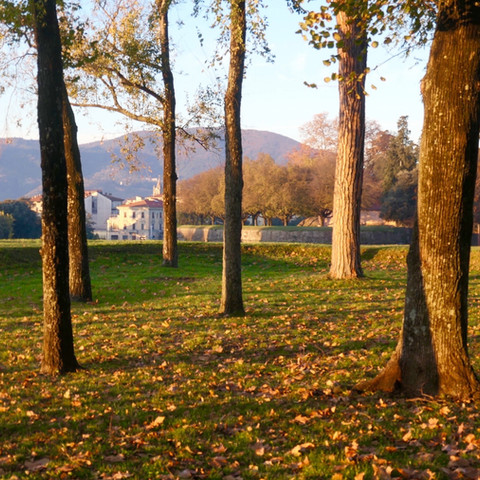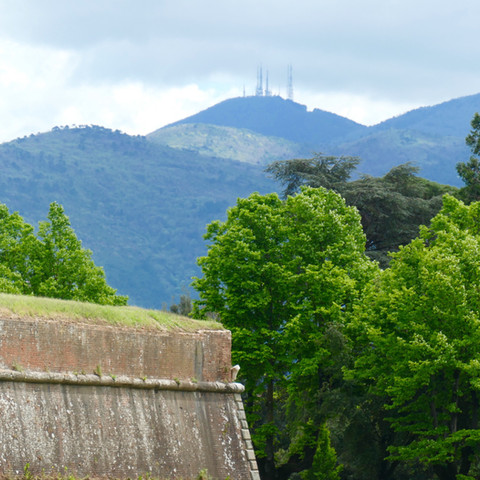Lucca's Walls
- My Kind of Italy

- Feb 28, 2021
- 6 min read
Updated: Nov 19, 2024
Le Mura

For our first article about Lucca there couldn’t be a better place to start than Le Mura (the walls) because everything in Lucca begins with these magnificent Renaissance era walls that encircle the centro storico and Lucca wouldn’t be the same without them.

"It’s only when you’re on le Mura that you first fall in love with the city and those who live here who are not natives always remember their first time on the walls and can point to the place where they sat and thought and talked and then decided they had to live here."
We live right across the street from this wonderful piece of history and like all the other apartment dwellers in and around the centro storico we view Lucca's walls as our garden which we happily share with locals and tourists alike because there’s plenty of space for everyone.
Every day we look out onto the walls from our kitchen window and almost every day we’re either walking or running or cycling on them. They change constantly with the time of day and with the seasons and they’re equally lovely on a cold winter morning when you barely see another soul as they are on a hot summer afternoon with a gelato melting in your hand.

Le Mura are the first thing you notice about Lucca before you enter one of the six gates to the centro storico. But only if you are approaching from the south or the east do you see le Mura at their most majestic.
When you merge onto the ring road you will catch your first sight of them across the wide expanse of greensward, rising up defiantly to deter 16th century invaders. The walls are topped with tall, mature plane trees and horse chestnut trees (buckeye), many of which are centuries old, making the walls seem much more imposing than their actual height of about 40 feet.

However the real magic of the walls is only revealed after you have entered the centro storico, walked up a few steps and are right on top of them. It is here that you realize that the English term “walls” is insufficient and doesn’t do justice to either the sheer acreage that is to be found on top of le Mura or the completely different way that this vantage point allows you to view both the centro storico and the mountains surrounding the plain of Lucca.
If you haven’t been here yet but you know New York, imagine the High Line 400 years from now but twice as long and twice as wide and you get some idea of the dramatic impact and uniqueness of le Mura in Lucca.

There are of course many other old city walls in Italy but most are now only fragments of what they once were and many are either partly or wholly inaccessible because they were built tall and narrow in a different era. Some are interesting enough like those around the pleasant Emilia town of Ferrara, but le Mura in Lucca are without peer in Italy in our opinion and probably also in the whole of Europe, though apparently the walls around Nicosia, built around the same time by the Venetians, are similarly impressive and Carcassonne has an attractive wall that is part medieval and part 19th century so is difficult to compare.

Not only are the Lucca walls completely intact but they are beautifully maintained and always in perfect condition unlike many others, including Ferrara, which have a slightly neglected feel about them.
One of the reasons why the Lucca walls are so impressive is that they form a very tight circle around the centro storico and cover the entire circumference of the old city in an unbroken line of 2.65 miles. The top of le Mura is flat and wide (about 20-25 yards) with two parallel lines of trees along both edges at about ten yard intervals, perhaps a thousand trees in all, and a paved strip along the middle for cyclists and runners and people just out for a stroll (la passeggiata). You remain above the traffic at all times with no obstacles to cross and no reason to stop; everything happens below you and nothing intrudes.
At irregular intervals along the walls you come across the eleven baluardi (bastions or ramparts) that disrupt the straight lines and bulge outwards, often at the point where the wall’s direction is turning to complete its circle. These bastions are impressive in size with many well over an acre and covered with grass and mature trees much like a small English park. Their original function was for cannon emplacements to increase the field of fire as part of an integrated defensive system to protect the gates to the city.
In the summer months with so much foliage on the walls it’s as if you’re on a country walk and even from eight miles away in the little town of Matraia perched high in the hills you can pick out Lucca far below from the concentric green rings of the trees and the expanse of lush meadows surrounding them. As you look out from the walls, away from the centro storico, the fields are interrupted only by the narrow canal that flows through and under Lucca and then meanders along before disappearing underground again.
Across the fields you see the newer parts of Lucca with some interesting early 20th century Liberty style buildings, and then in the distance looking north the mountains of the Alpi Apuane and the Appenine, and to the south the Monti Pisani separating Lucca from Pisa; mountains that are often attractively snow-capped in the winter or after a spring storm.
The views through the trees to the inside of the walls are equally beguiling and every few yards reveal another perspective on the centro storico. Walking along le Mura at about half the height of most of the old buildings is perfect for taking everything in. There’s the Duomo close to the walls in the south, the famous towers dotted throughout the town and a quaint assortment of balconies, old and new, often perched in unlikely places and bedecked with flowers, lots of herbs in pots and of course washing, because no one has dryers in Italy.
You can also enter two of the baluardi at street level where the tunnels form paths through the walls to the outside and these are used daily by cyclists and pedestrians to access the centro storico which has restricted car access. The Baluardo San Paolino is particularly interesting and typically has exhibits from the biennial Lucca event called Cartasia which showcases paper artworks created by many international artists, paper production being the main Lucca industry.
The first medieval walls around Lucca took well over 100 years to construct being completed in the 13th century and then continuously extended afterwards. And before that there were various Roman walls of which only a few pieces remain, and only one piece that we know of that is not on private property or hidden within the foundations of a later structure.
The 15th century for Lucca was characterized by numerous threats from Florence under Cosimo and then Lorenzo Medici, both of whom coveted the town. Then the brutal sack of Volterra in 1472 by mercenary forces under the patronage of Lorenzo may have helped to convince Lucca that it was time to build a stronger wall given the vulnerability of Lucca positioned on the flat land between Florence and the sea.

And if all this wasn’t sufficient reason, 1494 saw the start of the French invasions when large armies swept into Italy with the new generation of mobile artillery cast in bronze with much improved firepower. French cannons breached the fortress of Monte San Giovanni in only eight hours when in earlier times it had survived through many years of siege. Italian strongholds previously thought impregnable were suddenly easily destroyed.
Lucca commissioned its walls just 20 years later and the new military architecture for defensive walls resulted in le Mura being lower in height but massively thicker than previous walls with the incorporation of compacted earth embankments on the inside. These additional fortifications together with the new bastions were developed as the best defense against the new siege cannons.
Lucca took a full hundred years to finally complete le Mura in 1650, by which time the town was no longer threatened militarily by its immediate neighbors and the battles between Italian city states were long over. Yet both with and without the walls, for centuries Lucca held on to its independence until finally Napoleon swept all before him and presented Lucca to his sister Elisa.

By the 1800s it was clear that the walls served no modern military use and in any case, even before Napoleon’s arrival, the Austrians had already commandeered and removed all of the artillery pieces from the bastions. Beginning in 1822 plans were slowly developed to use le Mura solely for recreation. What is both surprising and fortuitous is that Lucca withstood the relentless march of urbanization in the second half of the 19th century and unlike Florence, Parma, Bologna and many other towns in Italy, it somehow managed to preserve the entire length of le Mura and also maintain a green belt outside the walls to allow them to be admired in their historical context.

And finally a word of advice if you plan to visit Lucca with young children. For most of the length of the walls there is only a slightly raised grassy ledge on the outside rim and no guardrails or fence, so don’t let small children run around by themselves because the drop to the fields below is vertical.


















